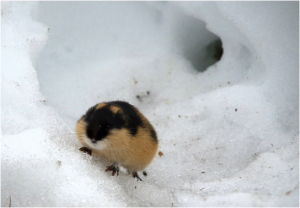There are parts of the world in the far north and far south that are very cold all year long. It takes a very special kind of animal to survive in these tough conditions! Come with me, Jungle Jim, to see which special features animals need to survive in the coldest climates.
Arctic Wolves
Arctic wolves live in Alaska, Northern Canada and Greenland. They have all the right characteristics to survive in really cold weather. What color do you think the ground is most of the year in cold places? You’re right, white! The ground usually has a white blanket of snow. That is why arctic wolves have white fur. Their white fur helps them blend in with the snow so they can hide from predators and sneak up on the animals they hunt. Arctic wolves have smaller ears and noses than other wolves. This helps hold in heat. They also have two layers of fur. The bottom layer of fur helps their skin stay dry and the outer layer of fur gets thicker in the winter and acts like a very warm winter coat. Arctic wolves also have paws that are specially adapted to walking on snow, ice and permafrost. Permafrost means the ground is frozen all year long, even when there is no snow in the summer.
Lemmings
 Lemmings are a type of rodent. Rodents are a family of animals that include mice, rats and voles. Lemmings live throughout the arctic circle in North America, Siberia and Europe. They are very small and have short tails, snouts and legs so they don’t loose heat out of extremities. Extremities is the name for parts of the body that extend from the main body, like ears, legs and tails. Lemmings don’t hibernate in the winter like many other animals. They stay awake and search for food. They eat roots and bulbs of plants found underground. Lemmings also make their homes in burrows under the snow to protect them from the cold.
Lemmings are a type of rodent. Rodents are a family of animals that include mice, rats and voles. Lemmings live throughout the arctic circle in North America, Siberia and Europe. They are very small and have short tails, snouts and legs so they don’t loose heat out of extremities. Extremities is the name for parts of the body that extend from the main body, like ears, legs and tails. Lemmings don’t hibernate in the winter like many other animals. They stay awake and search for food. They eat roots and bulbs of plants found underground. Lemmings also make their homes in burrows under the snow to protect them from the cold.
Narwhals
Narwhals are strange and rare creatures that live in the oceans above Russia and around Greenland. Narwhals have a large tooth that comes up from the top of their mouth. It looks very similar to a unicorn horn, they are even called the “unicorns of the sea.” In the summer Narwhals live near the shore and in the winter they move further out into the ocean and live under packed ice. Narwals can dive up to 5,000 feet deep! That is 500, ten feet deep swimming pools! Even though they can dive so deep they like to stay closer the surface of the water.
Beluga Whales
 Beluga whales live in the cold Arctic Ocean. These whales are mostly white and have a large hump on their head. When the arctic waters begin to freeze over Beluga whales migrate or move to warmer waters. These whales have thick layers of special fat called blubber that insulates them from icy cold water. Beluga whales also don’t have a dorsal fin. A dorsal fin is the tall fin that runs along many whales’ and sharks’ backs. This helps them keep heat in near their body. Beluga whales like to communicate with each other! They use clicks, whistles, groans and other noises to “talk” to each other. Can you make a whale noise?
Beluga whales live in the cold Arctic Ocean. These whales are mostly white and have a large hump on their head. When the arctic waters begin to freeze over Beluga whales migrate or move to warmer waters. These whales have thick layers of special fat called blubber that insulates them from icy cold water. Beluga whales also don’t have a dorsal fin. A dorsal fin is the tall fin that runs along many whales’ and sharks’ backs. This helps them keep heat in near their body. Beluga whales like to communicate with each other! They use clicks, whistles, groans and other noises to “talk” to each other. Can you make a whale noise?
Adélie Penguins
Adélie penguins live in the south, on the continent of Antartica. They spend most of their time at sea, eating krill. In the springtime, which is in September and October on the southern half of the world, they come to shore and make nests by scooping out spaces in the ground. Adélie penguins take turns foraging for food in the ocean and keeping their eggs warm and safe. Adélie penguins are built to be incredible swimmers. Their bodies are the perfect shape to move fast through the water and their wings act like flippers to help them swim.
Special Features
Special fur, fats, shapes and sizes, food and swimming abilities all help these animals survive in the coldest climates. They have what it takes to stay warm, find food and avoid predators in the coldest part of the world. How cold does it get where you live in the winter? What do you do to stay warm?
Sources
“Ten Interesting Facts about Beluga Whales” WWF
“Basic Facts about Narwhals” Defenders of Wildlife
